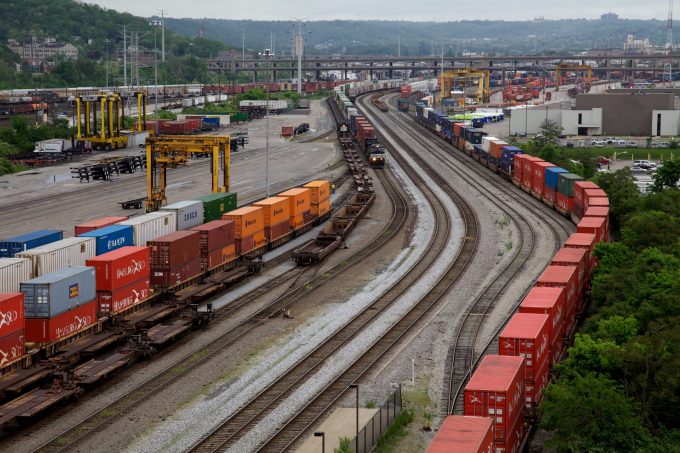Cargo chaos looms as strikes threaten Canada's ports and rail networks
Strike action has threatened to erupt at both Canada’s ports and rail networks, leaving the ...
TFII: SOLID AS USUALMAERSK: WEAKENINGF: FALLING OFF A CLIFFAAPL: 'BOTTLENECK IN MAINLAND CHINA'AAPL: CHINA TRENDSDHL: GROWTH CAPEXR: ANOTHER SOLID DELIVERYMFT: HERE COMES THE FALLDSV: LOOK AT SCHENKER PERFORMANCEUPS: A WAVE OF DOWNGRADES DSV: BARGAIN BINKNX: EARNINGS OUTODFL: RISING AND FALLING AND THEN RISING
TFII: SOLID AS USUALMAERSK: WEAKENINGF: FALLING OFF A CLIFFAAPL: 'BOTTLENECK IN MAINLAND CHINA'AAPL: CHINA TRENDSDHL: GROWTH CAPEXR: ANOTHER SOLID DELIVERYMFT: HERE COMES THE FALLDSV: LOOK AT SCHENKER PERFORMANCEUPS: A WAVE OF DOWNGRADES DSV: BARGAIN BINKNX: EARNINGS OUTODFL: RISING AND FALLING AND THEN RISING

US west coast ports are losing business to other gateways because of opposition from workers to productivity improvements, according to some observers.
However, labour unions believe intermodal connectivity, rather than port productivity, should be the focus for change.
Lately the Wall Street Journal has been the stage for a debate on west coast port productivity, with an opening salvo from Peter Tirschwell, VP maritime and trade at IHS Markit and editor-in-chief of the Journal of Commerce.
He argues that US ports have been increasingly vulnerable to disruption, owing in part to poor productivity compared with global gateways.
Officials of the International Longshore and Warehouse Union (ILWU) and Pacific Marine Association (PMA) published ripostes to his arguments.
Pointing to long delays caused by heavy congestion, Mr Tirschwell argued that US ports had fallen behind other international ports in terms of productivity. He cited global container port productivity rankings published in May by IHS Markit, which show no US port among the top 50 gateways.
In fact, only two North American ports made it into the top 50 – Lazaro Cardenas and Halifax.
The rankings are based on performance metrics like the average time it takes to load or unload a container in a standard port call and total port hours per ship call. Mr Tirschwell said that with larger ships, it took, on average, 24 seconds to move a container in Shanghai, Qingdao and Yantian – half the time needed at Los Angeles.
He also pointed out that at Asian ports ships were typically worked 24/7, or 168 hours a week, compared with 16 hours a day or 112 hours a week at Los Angeles-Long Beach.
In his analysis, high labour costs discourage employers from expanding work hours, and progress to automate more operations is crimped by opposition from the unions.
While Mr Tirschwell wrote about US ports overall, it is no coincidence that west coast gateways figured prominently in his argument. The migration of traffic from Asia to east coast ports is frequently attributed to lower costs. As Mr Tirschwell has pointed out elsewhere, the west coast’s share of imports from Asia fell from 77.5% in 2005 to 60.6% in 2019.
A study produced last year by Mercator found west coast ports were vulnerable to competition not only from the Canadian ports of Prince Rupert and Vancouver, but also to US rivals on the east and Gulf coasts. And East Coast ports offered cost advantages of up to $1,000 a container for intermodal cargo.
However, the ILWU dismisses the argument that the ports are not competitive. Jennifer Sargent Bokaie, communications director ILWU coast longshore division, said: “It defies commonsense and hard facts … we have moved more cargo than any other time in port history and employers are seeing record profits.”
The productivity numbers Mr Tirschwell cited were “cherry-picked to convey his personal point of view rather than the full and accurate story”, she added. “When discussing productivity you must take into account the entire supply chain – from container storage to the availability of trucks, chassis and rails to move it to warehouses, not just offloading times.”
But the ILWU agrees with Mr Tirschwell on increasing operating hours.
“Gates should open 24/7, but terminal operators refuse to consistently hire us for the third shift,” wrote ILWU international president William Adams in the Wall Street Journal.
As for the congestion that has stranded containers at the ports, the heads of the ports of Los Angeles and Long Beach have argued that increases in capacity at their facilities would not solve this problem. They say it requires a collective effort from all participants – lines, warehouse operators, rail carriers and equipment providers – to resolve this.
They noted that the LA/LB complex handled only slightly more containers in 2020 than in 2019, but experienced no significant congestion issues in 2019 because the rest of the supply chain was not strained.
Jim McKenna, president and CEO of the PMA, which represents the employers at the ports believed clogged-up terminals were the result of a cumulative collapse of the entire supply chain, overwhelmed by the surge of cargo.
While longshore workers worked more hours and moved record levels of cargo in congested terminals, facilities were forced to keep ships idle because there was no space for cargo, he added.
“This has nothing to do with longshore workers or port efficiency; it results from a supply chain not designed to accommodate the surge.”
Comment on this article
Gary Ferrulli
June 18, 2021 at 3:09 pmReality, lots of blame for the congestion in the US, several bottlenecks at inland points, including cargo interest warehouses as well a rail intermodal ramps. But first bottleneck on imports is at the ports and terminals on the US West Coast where productivity lags well behind the top 15 major ports in the world while compensation is the highest in the world. It goes downhill from there.